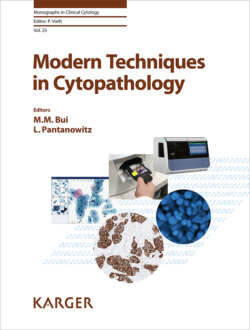Читать книгу Modern Techniques in Cytopathology - Группа авторов - Страница 21
На сайте Литреса книга снята с продажи.
Histology versus Cytology
ОглавлениеThe size of a tissue sample often determines whether the sample is processed via surgical pathology as a histology specimen, or via cytopathology as a cytology specimen. In general, if the tissue fragments are grossly visible, usually greater than 1 mm, they are processed as a histology sample. Dispersed cells, such as occurs in fluids, as well as samples with minute tissue fragments, such as in a fine-needle aspiration (FNA) biopsy, are typically processed as a cytology sample. The difference in size between histology and cytology specimens also dictates other steps in specimen management. Histology samples are often processed in the gross room, using tools such as forceps and scalpels, and slide preparation for immediate assessment (e.g., intraoperative consultation) is performed by generating a slide with a frozen section using a cryostat. Conversely, cytology samples are processed in a cytology laboratory, using tools and equipment such as a pipette, centrifuge, and vortex mixer, and immediate assessment is rendered from a slide smear or touch preparation.
While histology specimens are processed in a fairly standardized fashion across laboratories with formalin fixation, paraffin embedding, and hematoxylin and eosin (HE) staining, there is no consistent protocol for managing cytology specimens. For instance, there is no widely accepted standard for cytology specimen collection media, slide processing (e.g., smear, cytospin, liquid-based cytology; LBC), staining (e.g., Diff-Quik, Papanicolaou, and/or HE), and cell block preparation. Interestingly, the lack of standardization in cytology is partially a consequence of ongoing advancements in cytology (e.g., LBC), tissue acquisition techniques (e.g., minimally invasive procedures), and molecular diagnostics. New advances in cytology have not been matched with changes in standard operating procedures uniformly among laboratories. This dynamism requires continuous adaptation of cytology, including cell block processing.
